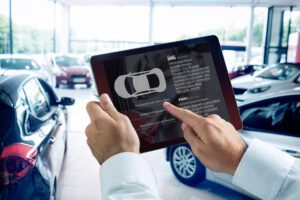Think about the last time you needed to purchase an item online. What comes to mind? Is it the ease of finding what you need? Did you feel that you could locate all the necessary information to make the right decision about the purchase? Was it more convenient than running to the store?
What made the online purchasing experience more preferable to going to a brick-and-mortar building? This question is at the heart of digital retailing. At its core, digital retailing is the process of allowing customers to interact with your website during various stages of the car buying process. There are specific touchpoints that enable them to find the information they need and ultimately make a purchase.
We now live in a world where individuals want convenience when they are shopping. Digital retailing allows customers the opportunity to get what they want at any time on a network-connected device. According to Smart Insights, the top reasons individuals choose to shop online instead of in-store are the ability to buy 24/7 (58 percent), price comparisons (54 percent), better prices (46 percent), saving time (40 percent), and convenience (39 percent).
 In line with this information, many customers want the option of handling most of the car buying process online. So, here are some ways instituting a digital retailing strategy can help your dealership and improve customer experiences.
In line with this information, many customers want the option of handling most of the car buying process online. So, here are some ways instituting a digital retailing strategy can help your dealership and improve customer experiences.
It Can Increase Your Profits
Before we go any further, it is worth it to discuss the revenue generating potential of digital retailing. Providing more car buying convenience for today’s shopper can pay off in the long-run. According to Cox Automotive, their digital retailing leads produce 51 percent higher gross profits when compares to other internet lead methods. These numbers make a case for connecting the principles of digital retailing to the customer experience. If done consistently, it can raise your revenues over time.
Provides Customers with Critical Information
According to eLend, 52 percent of dealers surveyed defined digital retailing as simply listing inventory online. This method is a decent start, but it is not moving the bar when it comes to giving customers what they need. The 2018 Cox Automotive Future of Digital Retail Study found that 51 percent of customers wanted to structure a deal online.
Showing them your discounts, add-on options, and F&I products upfront can give them the information they need regarding how they want to structure the deal. This tactic allows them to get a feel for pricing and decide how much they want to spend before they step into the door.
Can Handle Part of the Purchasing Information Online
The 2018 Cox Automotive Future of Digital Retail Study also revealed that 83 percent of customers want to do one or more steps of the purchasing process online. Many want to pass on the paperwork and begin the purchasing process before they step into the showroom. This could mean that paper applications are replaced with digital ones and that serious consumers can secure financing online. Again, the goal is to provide convenience while handing over control to the consumer. Starting part of the purchasing and financing procedure online shortens the in-store process for both parties and increases satisfaction on both sides.
Increases Service Department Sales
Many customers want the digital retailing experience to extend beyond car buying. According to the 2018 Cox Automotive Future of Digital Retail Study, 50 percent of car buyers surveyed said they would be more likely to service their vehicle at a dealership that had an “online scheduling and cost estimates option.” Car buyers don’t always want to have to walk in or call in to the dealership to schedule a service appointment. Creating a seamless process where customers can handle all this online makes it likely that they will purchase repair and maintenance services. Also, while each repair is unique, having an option where they could receive a general online estimate would make it even more likely for them to come in for service.
Allows More Time for Interaction and Learning in the Showroom
Because most of the purchasing process is occurring online, the role of the salesperson shifts. They now become a specialist or consultant that can guide customers through the final stages of the purchase. Instead of spending over an hour on F&I, customers can learn more about the car itself as well as the additional services the dealership offers. Customers can participate in test drives, and spend time learning about technological features that may come with the car. The showroom becomes an extension of the digital retailing experience, and it is being utilized most effectively: a place to educate and cultivate consumers.
Final Thoughts
Digital retailing has been around for a while. However, dealers are finally starting to realize the power it has to optimize their sales strategies. Making more of the purchasing and service selection process online allows customers to be in the driver’s seat. It acknowledges that we live in the “Amazon Age,” where shoppers want to have instant access to products. Dealers that can accomplish this could see themselves outpacing the completion in the coming years.








